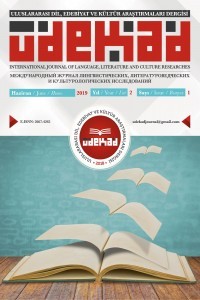TEHLİKEDEKİ / GİZLİ DİL DOMANİ SÖZCÜK LİSTESİ ÜZERİNE BİR ÇALIŞMA
Domani, Domani Sözcükleri, Tehlikedeki dil, Gizli dil
A STUDY ON WORD LIST OF ENDANGERED / SECRET DOMANI LANGUAGE
Dom language/Domani, Romani, Domani words,
___
- Evans, Nicholas (2010). Dying Words: Endangered Languages and What They Have to Tell Us, Wiley-Blackwell.
- Gülseren, Cemil (2001). “Darende'nin Gizli Dili Hazeynce”. Afyon Kocatepe Üniversitesi Sosyal Bilimler Dergisi 3, (2) 159-164
- https://sbd.aku.edu.tr/II2/13-cemil-gulseren.pdf 08.07.2018
- Heine, B.ve Kuteva, T. (2005). Language Contact and Grammatical Change, Cambridge University Press.
- Herin, Bruno (2015). “Domari: the language of the ‘Middle Eastern Gypsies”. The Middle East in London, Volume 11 - Number 5 October – November
- Herin, Bruno. (2016). Elements of Domari dialectology. Mediterranean Language Review 23:33–73.
- Johanson, Lars (2008). “Remodeling grammar: Copying, conventionalization, grammaticalization”. Language Contact and Contact Languages, Editörler: K. N. Siemund. P. Amsterdam/Philadelphia: John Benjamins Publishing Company.
- Matras, Yaron (1995). Romani in Contact, The History, Structure and sociology of a language, Introduction, John Benjamins Publishing Company Amsterdam/Philadelphia
- Matras, Yaron (2000). “Two Domari legends about the origin of the Doms”. Romani Studies, 5th series, 10: 53-79. Matras, Yaron (2002). Romani. A Linguistic Introduction. Cambridge.
- Matras, Yaron (2005). “Language contact, language endangerment, and the role of the ‘salvation linguist” Peter K. Austin (ed.) Language Documentation and Description, vol 3. London: SOAS. pp. 225-251
- Matras, Yaron (2009). Language Contact, Cambridge University Press.
- Matras, Yaron (2012). A Grammar of Domari, Mouton Grammar Library, Editors, Georg Bossong Bernard Comrie Matthew Dryer
- Mosel, Ulrike (2004). “Dictionary making in endangered speech communities”. In Peter K. Austin (ed.), Language documentation and description, vol. 2, 39-54. London: Hans Rausing Endangered Languages Project.
- Öztürk, Rıdvan (2015). “Kıbrıs’taki Gurbetlerin Gizli Dili”. s. 1399-1412. http://www.ayk.gov.tr/ 2015. E.T. 22.03. 03.04.2019
- Rehbein, Jochen-Herkenrath, Annette-Karakoç, Birsel (2009) “Turkish in Germany – On contact-induced language change of an immigrant language in the multilingual landscape of Europe”. STUF, Akademie Verlag, 62, 3: s. 171-204.
- Sevinçli, Efdal (2012). “Özel/ Gizli bir dil: Çepni dili”. Journal of Yaşar University, no 13, vol. 4, s. 1923-1949.
- Thije, Jan D. ten (2018). “Receptive Multilingualism”. Twelve Chapters on Multilingualism, David Singleton & Larissa Aronin (eds.) Bristol: Multilingual Matters. 227-263 Thomason, Sarah Grey (2001). Language Contact, Edinburgh: Edinburgh University Press.
- Varol, Orhan (2019). “Tehlikedeki Doğu Anadolu Domcası: Dilsel Etkileşim ve Birinci Dilde Gerileyici Çokdillilik”, Dilbilimde Güncel Tartışmalar, İşeri K, Editör, Dilbilim Derneği Yayınları, Ankara, ss 59-75
- Yıldırım, Faruk (2012). “Derleme Sözlüğündeki Gizli Dil Verileri Üzerine”. Turkish Studies - International Periodical For The Languages, Literature and History of Turkish or Turkic Volume 7/4, Fall 2012, p. 565-578, ANKARA-TURKEY Wei, Li (2007). “Dimensions of Bilingualism”. The Bilingualism Reader, Editör: L. Wei. 2nd ed. Routledge. s. 1-23
- Başlangıç: 2018
- Yayıncı: Reşat ŞAKAR
TEKSTİL TARİHİ BAĞLAMINDA HİNT GELENEKSEL GİYSİSİ SAREE (SARİ) ÜZERİNE KÜLTÜREL BİR ANALİZ
ELEKTRONİK KÜLTÜR ORTAMINDA NEOLOJİZM
TEHLİKEDEKİ / GİZLİ DİL DOMANİ SÖZCÜK LİSTESİ ÜZERİNE BİR ÇALIŞMA
RİSÂLETÜ’N-NUSHİYYE’DE Kİ / KİM BAĞLAÇLARININ KULLANILIŞI
KÜLTÜRDEN BİLGİYE DİLİN TEZAHÜRÜ -Necati Öner Fikriyatından Hareketle Çözümleme Denemesi-
MURAKAMİ’NİN HAŞLANMIŞ HARİKALAR DİYARI VE DÜNYANIN SONU ADLI ESERİNDEKİ KAFKAESK İMGELER
MEVLÂNÂ’NIN ŞİİRİNDE BİR İLETİŞİM YÖNTEMİ OLARAK SESSİZLİK
Pouneh ABDOLLAHİFARD, Funda TÜRKBEN AYDIN
TIM CROUCH’UN ENGLAND OYUNUNDA TRANSPLANTASYON VE SÖMÜRÜ
ÇENGİNÂMEDEN TAŞANLAR: ENDERÛNLU FÂZIL’IN ŞARKILARINDA ÇENGİLER
